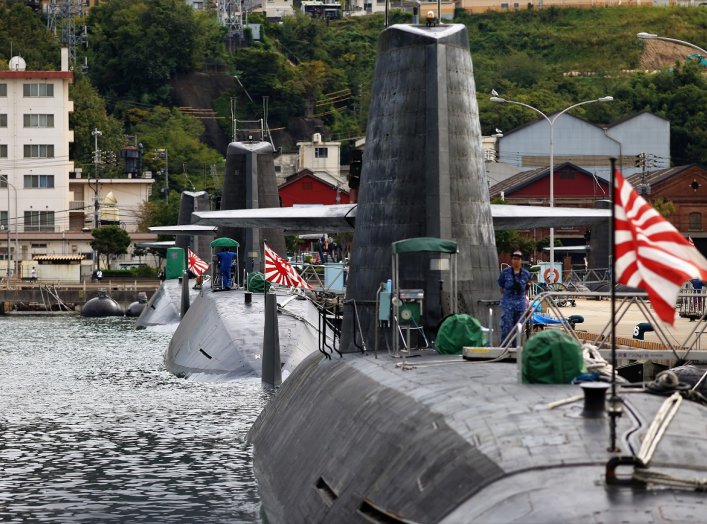
The combination of long-endurance stealth, sensors, and modern torpedoes and missiles makes the Soryu class an effective hunter-killer.
The Second World War taught Japan valuable lessons. The first—don’t start wars—is an obvious conclusion that has been taken to heart. Other lessons were the result of the wartime Allied air and naval blockade of the country, which brought it to the brink of starvation. For Japan, poor in resources and arable land, to survive the next war, the air and sea lanes must stay open, and for that to happen, Japan must have top-flight air and naval forces.
Japan’s postwar submarine fleet is one of the best in the world. With an authorized total of twenty-two submarines, the Japan Maritime Self Defense Force’s submarine fleet is also one of the largest. Japan builds its own submarines, with the work split between Mitsubishi Heavy Industries and Kawasaki Heavy Industries, both based in the port city of Kobe.
Japan takes an iterative approach to submarine construction, with a new submarine class introduced roughly every twenty years that builds upon previous ones. The current class, Soryu, builds upon the older Oyashio class, and the two classes form the entirety of the fleet. Each Soryu features a high degree of automation, reducing crew size to nine officers and fifty-six enlisted men—down ten personnel from the Harushio-class of the mid-1990s.
At 4,200 tons submerged, the nine Soryu-class submarines are the largest submarines built by postwar Japan. Each is 275 feet long and nearly twenty-eight feet wide. They have a range of 6,100 nautical miles and can reportedly dive to a depth of 2,132 feet, or two-fifths of a mile. The Soryu class features an X-shaped tail, reportedly for increased maneuverability in approaching the seabed. This maximizes the sub’s maneuvering room in shallow and littoral waters, particularly the straits in and around Japan that mark key invasion routes.
Each submarine has an optronic mast and ZPS-6F surface/low-level air search radar for detection of enemy ASW and maritime patrol craft. As submarines, however, the main sensor is sonar, represented by the Hughes/Oki ZQQ-7 sonar suite incorporating one bow-mounted sonar array and four flank sonar arrays. The subs also have a towed sonar array for rear acoustic detection.
The Soryu class has six 533-millimeter torpedo tubes mounted in the bow. Armament consists of Type 89 heavyweight homing torpedoes with a range of twenty-seven nautical miles and a maximum operating depth of 2,952 feet. The standard diameter torpedo tubes, along with strong American ties, mean the Soryu is also armed with UGM-84 submarine-launched Harpoon missiles. According to Combat Ships of the World, there are unconfirmed reports that the submarines carry a warshot of thirty weapons instead of the twenty of previous classes. They can also lay mines.
The Soryus have extensive active defense systems, in the form of the ZLR-3-6 electronic countermeasures suite and two three-inch underwater countermeasures launchers for launching acoustic devices. On the passive side, the entire submarine is covered in acoustic tiling to reduce both the signature of enemy active sonar signals and sounds from the inside the ship.
Propulsion is what the class is most famous for. Each can make thirteen knots surfaced and twenty knots submerged, powered by twelve Kawasaki 12V 25S diesel engines and one tandem Toshiba electric motor. For silent running, each submarine is equipped with four Stirling V4-275R Mk air independent propulsion systems licensed from Sweden that can power the submarine underwater for up to two weeks. There are also rumors that the last ships built will trade their AIP units for lithium-ion batteries.
The Soryu class isn’t perfect, though: one major criticism of the boats during the Australian submarine competition was their relatively short operating range. At 6,100 nautical miles, the Soryu’s range wasn’t an issue for their original mission: protecting the home waters of Japan.
Australian Soryus, however, would have had to travel 3,788 miles from their base at HMAS Stirling just to reach the vicinity of Taiwan, a voyage that would necessitate at least one refueling stop, and probably two. For the Australian bid, the Soryus were to be lengthened six to eight meters for improved crew habitability and increased range, but the need to modify the submarine for Australian requirements likely worked against Japan.
The combination of long-endurance stealth, sensors, and modern torpedoes and missiles makes the Soryu class an effective hunter-killer. It is, however, a specialized killer, as Australia came to realize, and would have been a fish out of water in Australian service.
As potent as the class is, expect a replacement class that builds upon this hunter-killer within the next decade. Japan is exploring unmanned underwater vehicles, and toward that end, underwater communications and underwater wireless power-transmission methods. What will Son of Soryu look like? Stay tuned.


No comments:
Post a Comment